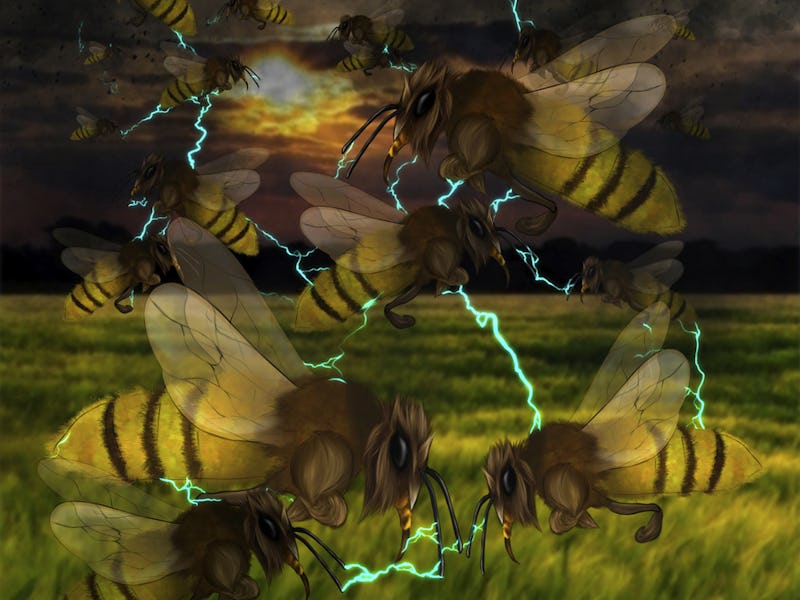The “butterfly effect” may be real, scientists find in bizarre insect study
There's no way you'll predict what they found.

Chaos theorists refer to the “butterfly effect” to describe seemingly insignificant events — like the ripple of a butterfly’s wing — that can have unintended consequences. But there might be a more literal “butterfly effect” taking place right before our very eyes, scientists suggest.
According to new research, insects actually carry electrical charges — and these charges can have enormous effects on the atmosphere, potentially impacting even the weather. The findings were published Monday in the journal iScience.
“It might be a butterfly effect — we don’t know, and that makes exploring the role of insects in the great atmospheric system worth investigating,” Ellard Hunting, lead author on the study and a research associate at the University of Bristol, tells Inverse.
The background you need — Before you can understand the effect of insects on the atmosphere, you have to understand how electrical charges in the atmosphere work. The Earth’s atmosphere always carries an electrical charge to a lesser or greater degree, which scientists refer to as the Potential Gradient (PG).
But this is far from a new area of research. Scientists have been studying atmospheric electricity since the early 1700s.
“Fueled by an interest in lightning, scientists aimed to unravel whether thunderclouds contained electricity in both the laboratory and in the atmosphere. However, electrification of the air was also detected during fair weather conditions,” Hunting explains.
Scientists concluded that atmospheric electricity is primarily driven by meteorological events like thunderstorms and shower clouds, though factors like human pollution also affect it. Researchers, therefore, want to know how electrical charges impact clouds. But few studies have considered the impact of insects’ electrical charges, especially since these animals congregate in swarms large enough to affect the atmosphere.
Until now.
A graphic illustration of a honeybee’s electrical charge.
What they found — In their new research, scientists identify three key findings showing that insects contribute “a hitherto unrecognized source of electrical variability in the atmosphere.”
First: flying insects — like honeybees — carry an electrical charge.
Second: the denser the swarm of honeybees, the greater the impact on atmospheric electricity.
Third, and, perhaps, most startling: insects’ electrical charges can have just as significant an impact on atmospheric electricity as natural weather events.
“Collectively, this evidence suggests that a honeybee swarm contains enough charge to affect the atmospheric PG,” write the researchers.
How they did it — To confirm that honeybees carry electrical charges, researchers placed an electrical field monitor near a dense swarm of migrating honeybees near the University of Bristol. They also placed a control monitor in a field where there were no bee swarms. The monitor near the bee swarm picked up an increase in electrical charge whereas the control monitor detected no such effect, confirming their hypothesis.
Second, the researchers wanted to calculate how the insects’ electrical effects on the atmosphere compared to the electrical impacts of meteorological events like clouds and dust storms. They calculated the electrical charge of dense swarms of three different types of insects, including locusts, whose notorious swarms are “biblical” in scale according to the researchers.
Can swarms of honeybees impact the atmosphere? Researchers say yes.
“Our calculations show that desert locust (Schistocerca gregaria) swarms are capable of exceeding charge densities reported for electrical storms and clouds,” write the researchers.
Why it matters — Through their findings, the researchers have, in effect, proposed a novel scientific idea: a swarm of honeybees or desert locusts can have profound impacts on a fundamental aspect of our atmosphere.
But researchers are still uncertain what their findings mean in terms of broader weather phenomena.
“How it influences weather, we don’t really know,” Hunting says. “It really depends on which weather phenomena.”
The knowledge that insects impact the atmosphere’s electricity has bigger implications for science. The Potential Gradient affects the “movement of ions and aerosols in the atmosphere, and leads to charging of droplets and particles in some clouds,” according to Hunting.
According to the researcher, insect swarms likely won’t drive weather events like thunderstorms, but they could impact the movement of these atmospheric aerosols.
What’s next — Further research will dive into this previously unexplored field of scientific research and may go beyond insects, since organisms like birds and microbes also carry electrical charges.
“We only recently discovered that biology and static electric fields are intimately linked,” Hunting says, adding “This makes it an exciting new area of empirical research.”
This article was originally published on